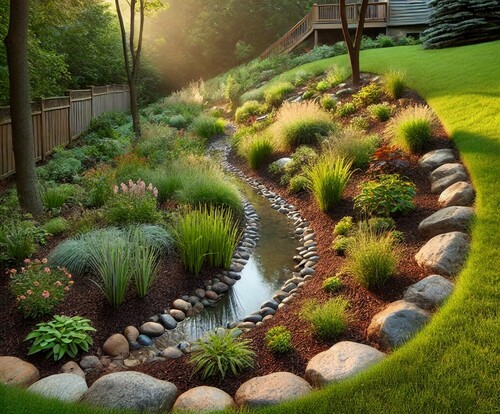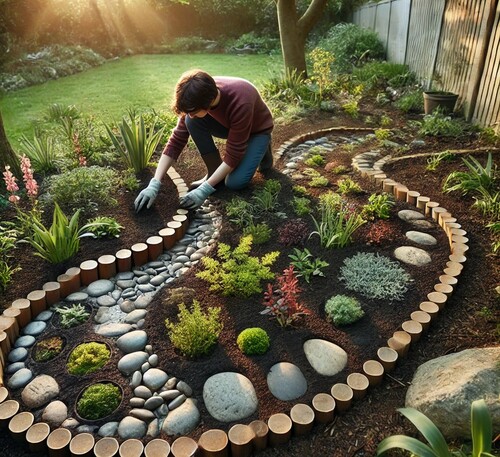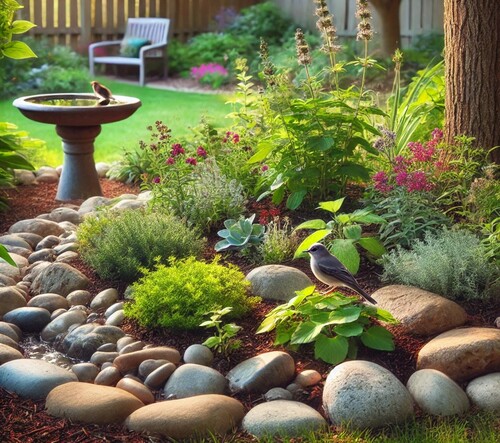DIY Rain Garden Guide 2024: Transform Your Yard & Protect Local Waters
Introduction
A rain garden is a shallow depression in your landscape designed to collect and filter stormwater runoff , and building one is easier than you might think! As both a beautiful garden feature and an eco-friendly solution to water management, a DIY rain garden offers multiple benefits for homeowners and the environment. These simple yet effective gardens can transform landscapes while making a significant environmental impact. This comprehensive guide covers everything needed to create a rain garden, from planning and design to plant selection and maintenance.
Why Build a Rain Garden?
Rain gardens are gaining popularity for good reason. A properly designed rain garden can process up to 30 percent more water than a typical lawn, significantly reducing runoff and preventing pollutants from entering local waterways. The benefits are numerous:
- Water conservation: By capturing rainwater, these gardens reduce the need for irrigation while providing a natural water source for plants.
- Pollution Reduction: They filter out up to 90 percent of chemicals and 80 percent of sediment from runoff, including common pollutants like lawn fertilizers, pesticides, and oil from vehicles.
- Wildlife Habitat: They attracs beneficial insects, birds, and butterflies, creating a vibrant ecosystem in the backyard.
- Property Value: They add an attractive, low-maintenance landscape feature that can increase property value by up to 5 percent.
- Cost Savings: They can reduce water bills and potential flooding damage, with some homeowners reporting up to 30 percent savings on their water bills.
Environmental Impact
When rain falls on impervious surfaces like roofs, driveways, and parking lots, it picks up pollutants before flowing into storm drains and, eventually, our waterways. Rain gardens interrupt this process, allowing water to slowly infiltrate the ground while natural processes remove pollutants. A typical residential rain garden can process thousands of gallons of water annually, making a significant impact on local water quality.
Planning Your Rain Garden

A Sloping Backyard with a Rain Garden for Stormwater Control
Location Selection
The first step in creating your rain garden is choosing the right location. Here are key factors to consider:
- Distance from Buildings: Place at least ten feet from house foundations to prevent water damage or basement seepage.
- Sunlight: Most native rain garden plants prefer full to partial sun, though some varieties thrive in shade.
- Slope: Ideal on gentle slopes, avoiding areas with more than 12 percent grade. For steeper areas, consider terracing or alternative water management solutions.
- Utilities: Always call 811 before digging to locate underground utilities. Wait the required time (usually 48-72 hours) for utility companies to mark their lines.
- Existing Features: Consider proximity to trees (avoid major root systems), property lines, and existing landscaping.
Size Calculation
To determine the right size for your rain garden, follow this simple formula:
- Measure the drainage area (roof or paved surface directing water to your garden)
- Multiply by 0.1 for sandy soils, 0.2 for loamy soils, or 0.3 for clay soils
- The result is your recommended rain garden size in square feet
For example, if you’re collecting runoff from a 500-square-foot roof and have loamy soil: 500 × 0.2 = 100 square feet for your rain garden.
Consider breaking larger gardens into multiple smaller ones for easier management and more diverse landscaping options.
Materials and Tools Needed
Essential Tools:
- Shovel and spade for digging and edging
- Wheelbarrow for moving soil and materials
- Level (both standard and laser level if possible) for ensuring proper grading
- Tape measure for accurate dimensions
- Stakes and string for marking the garden perimeter
- Rake for soil preparation and final grading
- Optional: Rototiller for soil preparation in larger gardens
- Gloves, safety glasses, and sturdy footwear
Materials:
- Native plants suited to your specific region and climate
- Mulch (hardwood recommended)—calculate 2-3 cubic yards per 100 square feet
- Compost or soil amendments specific to your soil type
- Optional: Stones or decorative elements for enhanced aesthetics
- Erosion control fabric for stabilizing slopes if needed
- Edging material if desired (natural stone, metal, or plastic)
Step-by-Step Construction Guide

Planting Native Plants in a Rain Garden for Stormwater Management
1. Site Preparation
Start by marking your garden’s perimeter using stakes and string . Create an outline that follows natural contours for a more organic look. Remove grass and dig to a depth of 4-6 inches, creating a flat bottom and sloped sides. The sides should have a gentle grade to prevent erosion .
For lawn removal, you have several options:
- Manual removal with a spade (best for small areas)
- Sod cutter rental (efficient for larger areas)
- Sheet mulching (lay cardboard and mulch months in advance)
2. Soil Testing and Amendment
Test your soil drainage by:
- Digging a 12-inch-deep hole
- Filling it with water and letting it drain
- Refilling and timing how long it takes to drain
If water takes more than 24 hours to drain, you’ll need to amend the soil. Here’s how:
- For Clay Soils: Add coarse sand and compost in a 1:1 ratio
- For Sandy Soils: Add compost to improve water retention
- For Compacted Soils: Use a rototiller to break up soil before amending
Test soil pH and nutrient levels with a home kit or through your local extension office. The ideal pH for most rain garden plants is between 5.5 and 7.0.
3. Creating the Depression
- For Clay Soils: Dig 6-8 inches deep
- For Sandy Soils: 4-6 inches is sufficient
- Create a level bottom using a large level or string level.
- Form a berm on the downhill side using excavated soil, compacting it well.
- Consider installing an overflow pathway for extreme rain events.
- Grade the sides to a maximum 3:1 slope (3 feet horizontal for every 1 foot vertical).
Selecting and Planting
Plant Selection
Choose native plants adapted to both wet and dry conditions. Organize them in three zones:
1. Basin (Lowest Area)
- Plants that tolerate standing water
- Examples: Rush, iris, swamp milkweed
- Suggested spacing: 1-2 feet apart
- Best planted in groups of 3-5 for visual impact
2. Slope
- Plants that prefer moist but not saturated soil
- Examples: Black-eyed Susan, coneflower , Joe Pye weed
- Mix heights and bloom times for continuous interest
- Include both flowers and ornamental grasses
3. Upland Edge
- Drought-tolerant plants
- Examples: Butterfly weed , little bluestem, y arrow
- Consider evergreen species for year-round structure
- Use as a transition to existing landscape
Planting Tips
- Space plants according to mature size to prevent overcrowding
- Plant densely to prevent weed growth and increase water absorption
- Apply 2-3 inches of hardwood mulch, keeping it away from plant stems
- Water deeply until established, typically 3-4 weeks
- Consider planting in spring or fall for optimal establishment
- Label plants for easy identification during maintenance
Maintenance Guidelines

A Person Removing Weeds Around a Backyard Rain Garden
First Year Care
- Water during dry periods, especially in the first three months
- Remove weeds regularly before they set seed
- Replace plants that don’t thrive, noting patterns of success
- Maintain 2-3 inches of mulch, replenishing as needed
- Monitor for erosion and address any issues promptly
- Trim spent blooms to encourage continued flowering
Long-Term Maintenance
- Perform annual spring cleanup to remove dead plant material
- Remove sediment buildup that may affect water flow
- Divide overgrown plants every 3-4 years to maintain garden health
- Refresh mulch as needed, typically every other year
- Prune any woody plants to maintain appropriate size
- Document changes and successful plant combinations
Troubleshooting Common Issues
- Standing Water: If water stands for more than 48 hours, improve drainage by deepening the garden or amending soil.
- Erosion: Add more plants, especially on slopes, or adjust grading.
- Weeds: Perform regular removal and proper mulching prevent issues.
- Plant Failure: Note which plants don’t thrive and replace with hardier species.
- Animal Damage: Use physical barriers or resistant plants if deer or other wildlife become problematic.
Enhancing Your Rain Garden

A Backyard Rain Garden with Native Plants and a Birdbath
Adding Decorative Elements
- Install stepping stones for access during maintenance
- Place decorative rocks for visual interest and microhabitats
- Add a rain chain or decorative downspout to direct water
- Consider a small footbridge for larger gardens
- Install solar lighting to highlight the garden at night
- Add a decorative garden stake or rain gauge
Wildlife Attraction
- Include plants that provide food and shelter throughout the seasons
- Add a shallow birdbath or puddling area for butterflies
- Create hiding spots with rocks or logs for beneficial insects
- Avoid using pesticides to maintain a healthy ecosystem
- Consider adding a small brush pile nearby for ground-dwelling creatures
Conclusion
Creating a DIY rain garden is a rewarding project that benefits both your property and the environment. By following this guide, you can create a beautiful, functional landscape feature that manages stormwater while providing a habitat for local wildlife. Remember, every rain garden makes a difference in protecting our waterways! For expert guidance on incorporating a rain garden into your larger landscape design, contact Arborist Now —we’re here to help your green dreams become reality.


